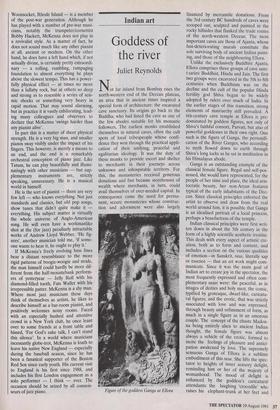Indian art
Goddess of the river
Juliet Reynolds
Not far inland from Bombay rises the north-western end of the Deccan plateau, an area that in ancient times inspired a special form of architecture: the excavated cave sanctuary. Its origins go back to the Buddha, who had listed the cave as one of the few abodes suitable for his monastic followers. The earliest monks established themselves in natural caves, often the cult spots of local tribespeople whose confi- dence they won through the practical appli- cation of their unifying, peaceful and egalitarian ideology. It was the duty of these monks to provide escort and shelter to merchants in their journeys across unknown and inhospitable territory. For this, the monasteries received generous donations and fast became storehouses of wealth where merchants, in turn, could avail themselves of ever-needed capital. In consequence came the need for perma- nent, secure monasteries whose construc- tion and adornment were also largely
Figure of the goddess Ganga at Ellora financed by mercantile donations. From the 3rd century BC hundreds of caves were scooped out, sculpted and painted in the rocky hillsides that flanked the trade routes of the north-western Deccan. The most important caves are those of Ajanta, whose fast-deteriorating murals constitute the sole surviving body of ancient Indian paint- ing, and those of the neighbouring Ellora. Unlike the exclusively Buddhist Ajanta, Ellora comprises three groups of cave sane- t•iaries: Buddhist, Hindu and Jain. The first two groups were excavated in the 5th to 8th centuries when Buddhism was on the decline and the cult of the popular Hindu fertility god Shiva began to be widely adopted by rulers over much of India. In the earlier stages of this transition, strong elements of matriarchy still prevailed. A 6th-century cave temple at Ellora is pre- dominated by goddess figures, not only of Shiva's faithful consort, Parvati, but also of powerful goddesses in their own right. One such is the figure of Ganga, the personifi- cation of the River Ganges, who according to myth flowed down to earth through Shiva's long locks as he sat in meditation in his Himalayan abode.
Ganga is an outstanding example of the classical female figure. Regal and self-pos- sessed, she would have represented, for the people of her time and place, the ideal aris- tocratic beauty, her non-Aryan features typical of the early inhabitants of the Dec- can. Since classical principles exhorted the artist to observe and draw from the real world around him, it is possible that Ganga is an idealised portrait of a local princess, perhaps a benefactress of the temple.
Indian classical principles were first writ- ten down in about the 5th century in the form of a highly scientific aesthetic treatise. This deals with every aspect of artistic cre- ation, both as to form and content, and includes a section on the various qualities of emotion—in Sanskrit, rasa, literally sap or essence — that an art work might com- municate. Since it was the main goal of Indian art to create joy in the spectator, the most frequently expressed and often com- plementary rasas were: the peaceful, as in images of deities and holy men; the comic, typified by grotesque, dwarf-like, caricatu- ral figures; and the erotic, that was strictly associated with love and was expressed, through beauty and refinement of form, as much in a single figure as in an amorous couple. The concept of the chaste Madon- na being entirely alien to ancient Indian thought, the female figure was almost always a vehicle of the erotic, formed to incite the feelings of pleasure and antici- pation awakened by love. The supremely sensuous Ganga of Ellora is a sublime embodiment of this rasa. She lifts the spec- tator to heights of inner sensory delight, reminding him or her of the majesty of womanhood. The mood of delight is enhanced by the goddess's caricatural attendants: the laughing 'crocodile' who raises his elephant-trunk at her feet and
the sweetly smiling, roly-poly dwarf upon whom she leans. Were her right arm still intact, one would see it delicately curved above the shoulder, a bird perching on her hand, it too bringing a touch of joy to the composition.
Finally, as a goddess, Ganga embodies the rasa of peace, communicated by the stability and pose of the tension-free figure. This is attained through the powerful artic- ulation of the curvilinear form composed, with geometric precision, within the recti- linear planes of the whole structure. In Ganga a master has created abstract from concrete, giving order and permanence to a human ideal.
This article is one of an occasional series by Juliet Reynolds on masterpieces of Indian art.



















































 Previous page
Previous page